GROWING SWEET CORN
By
Senior Research Officer, Hj. Yakup b. Pendak
Introduction
Sweet corn (Zea mays saccharata Sturt) is a cereal crop from the Graminae family. This annual crop can be grown in temperate and tropical regions. The cobs are harvested when they are still green and the kernels are well-filled and milky yellow in colour. At this stage the silk is dry and dark brown.
|
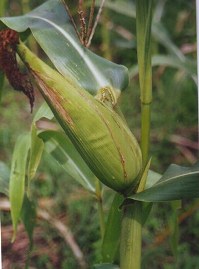
|

|
| cob ready for harvesting |
In Sarawak, sweet corn is cultivated on a small scale by farmers, either for their own consumption or for sale. The farmers usually grow sweet corn during the padi off season. The cobs are usually eaten after they are boiled or roasted. Sweet corn also can be used as ingredients for ice cream and jellies while the corn starch is used to make traditional cakes and infant food.
Site selection
Sweet corn can be grown on most soils provided the drainage is good but usually it performs best on deep loams and silty loams containing an abundance of organic matter and well supplied with available nutrients. Sweet corn can also be grown on moderately acid soils (pH 5.0), but pH range of 6.0 to 7.0 is most favourable. An ideal site for planting sweet corn is an open flat or gently sloping land. Continuous planting with sweet corn is not recommended. Crop rotation whereby sweet corn is grown alternately with groundnut, sweet potato or other crops is very beneficial in terms of crop production and soil management.
Land preparation
Land preparation includes felling, burning and tilling, and on low-lying land, the construction of drains to remove excess water. Land tilling can be done either manually using a hoe or mechanised using a pedestrian power tiller. A reasonably smooth and firm ploughed area provides favourable soil condition for germination and seedling development. Too much tillage, however, may destroy the soil structure and result in soil compaction which should be avoided.
|
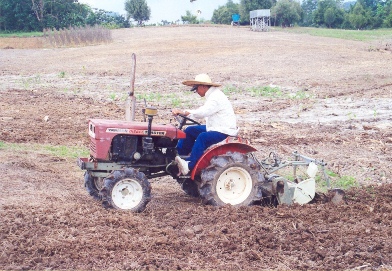
|
| mechanised ploughing |
Planting
When land preparation has been completed, 2 seeds are dibbled in each planting hole. The plants are spaced 60 cm between rows and 60 cm within the row. This spacing would require a seeding rate of 10-12 kg/ha seed.
|
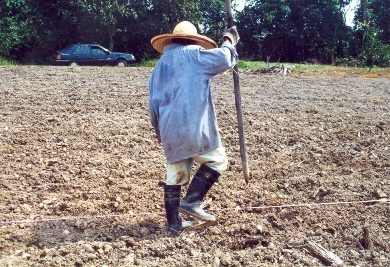
|
| making of planting hole |
|

|
| planting |
|

|
| sweet corn plot |
Isolation
Sweet corn should not be planted together with grain corn or different varieties of sweet corn as this will affect the quality or sweetness of the fresh cobs.
Weed Control
Sweet corn does not tolerate strong weed competition. It is important that the field be kept free from any weeds during the first one month. Weed control can be done manually or mechanically whereas in a large plantation, it is necessary to use herbicides or mechanical method to control weeds. A very good herbicide to use is Atrazine 80 WP at 5.6 kg/ha sprayed twice; the first spray applied as a pre-emergence and the later spray at one or one and a half months after sowing.
Manuring
Liming should be done 3 weeks before planting but this depends on the soil acidity. The exact type and rate of fertiliser will, of course, depend on soil type. A 12:12:17:2 compound fertiliser at the rate of 600 kg per hectare may be used as a general recommendation. During planting, 12:12:17:2 fertiliser is applied at the rate of 300 kg per hectare and six weeks later, another round of the same amount is applied. The fertiliser is applied around each plant. Additional fertiliser at a reasonable rate is applied if the growth is not encouraging. Organic manures such as chicken dung, cow manure and compost at 1-2 m.t./ha can also be used as basal dressing.
Harvesting
Harvest as soon as the kernels are well-filled (65-75 days after planting). It is important to note that sweet corn can lose its sweetness rapidly and should be marketed and consumed immediately after harvest. Selective harvesting has to be practised.
|
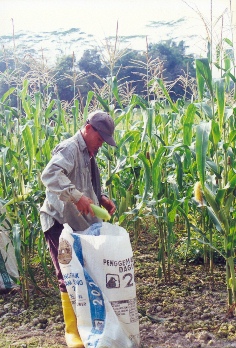
|

|
| harvested cob |
Recommended Sweet Corn Varieties
There are many sweet corn varieties available in the market; they are mainly hybrids or composites. Studies done by the Department of Agriculture, Sarawak had shown that ‘Hybrid No.5’, can produce 5.0-6.0 mt/ha of fresh cobs without skin. The brix reading (measure of sweetness) for this variety was 16.2%. This hybrid is suitable for fresh consumption, frozen corn and for canning. For composite varieties, ‘Masmadu’ and ‘Thai Super Sweet’ can produce 3.0-4.0 mt/ha fresh cobs without skin. In terms of sweetness, ‘Masmadu’ and ‘Thai Super Sweet’ had recorded a brix reading of 15.5% and 13.7% respectively.
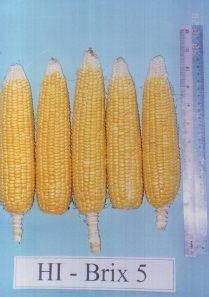 |
 |
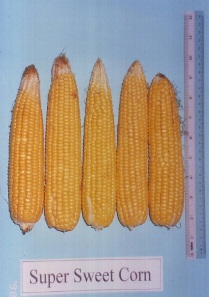 |
| Hybrid No.5 |
Masmadu |
Thai Super Sweet |

